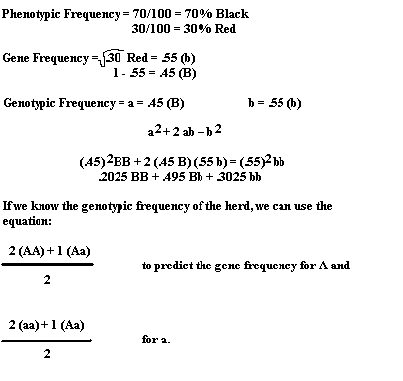Population Gene Frequencies
Scientists use population genetics to figure what a certain gene frequency may be. The principle that is used is the Hardy-Weinberg Theory. The only problem with this theory is that five rules must be followed within the studied population. They include:
1. No selection 2. No migration 3. No mutation 4. Random mating 5. Large population
If all of these rules apply, then the equation for the theory can be used.

(a) represents the gene frequency of the dominant allele in the population, and (b) is the frequency of the recessive allele.
When using this equation, the first thing to find is the phenotypic frequency. This is simply the percent of that one phenotype in the population.
Since we know that the homozygous recessive trait has two recessive alleles, we can take the square root of that phenotypic frequency (B) and get (b). (a) can be found as: 1-b = a.
The gene frequencies of (a) and (b) can then be placed into the original equation:

Let us try an example:
In a herd of 100 Angus cattle, 70 are black and 30 are red (bb). What are the phenotypic, gene, and genotypic frequencies?

- Continue to Gene Frequency Problems
- Return to Main Menu
|
|
© 2003-2025:
USA · USDA · NRPSP8 · Program to Accelerate Animal Genomics Applications.
|
||